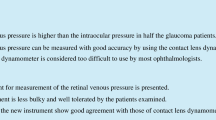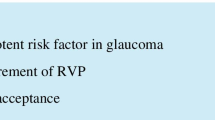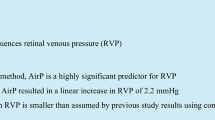Abstract
Purpose
Using a new Goldmann contact lens associated ophthalmodynamometric device, it was the purpose of the present study to determine the central retinal vein collapse pressure in eyes with retinal vein occlusions or retinal venous stasis.
Methods
The prospective clinical non-interventional comparative study included 19 patients with central retinal vein occlusion (n=8), branch retinal vein occlusion (n=4), or retinal venous stasis (n=7) and 42 subjects of a control group. With topical anesthesia, a Goldmann contact lens fitted with a pressure sensor was put onto the cornea. Pressure was exerted on the globe by pressing the contact lens, and the pressure value at the time when the central retinal vein started pulsating was noted.
Results
Central retinal vein collapse pressure measured 103.6±25.4 arbitrary units (AU) in eyes with central retinal vein occlusion what was significantly higher than in the eyes with retinal venous stasis (58.1±37.5 AU; p=0.02) and the eyes with branch retinal vein occlusion (43.8±25.5 AU; p=0.004). In the latter two groups, the measurements of the central retinal vein collapse pressure were significantly (p<0.001) higher than the measurements in the eyes of the control group (4.2±7.8 AU).
Conclusion
As measured by a new ophthalmodynamometer with direct biomicroscopic visualization of the central retinal vessels during examination, central retinal vein collapse pressure is significantly higher in eyes with central retinal vein occlusion, followed by eyes with branch retinal vein occlusion, eyes with retinal venous stasis and, finally, normal eyes. These findings may have diagnostic and therapeutic implications.
Similar content being viewed by others
Explore related subjects
Discover the latest articles, news and stories from top researchers in related subjects.Avoid common mistakes on your manuscript.
Introduction
Central retinal vein occlusion and branch retinal vein occlusion are among the ocular diseases that markedly reduce vision and are associated with severe complications such as neovascular glaucoma and intraocular hemorrhages. One reason for retinal vein occlusions may be increased outflow resistance leading to elevated pressure in the retinal veins. It was, therefore, the purpose of the present study to determine the pressure in the central retinal vein as an indirect measure of the outflow resistance in eyes with retinal vein occlusions or retinal venous stasis.
Ophthalmodynamometry may be a technique allowing to assess the pressure in the central retinal vein. Popular in the 1960s and 1970s, ophthalmodynamometry included increasing the intraocular pressure by exerting a standardized pressure on the globe and observing the optic nerve head through an indirect or direct ophthalmoscope or an ophthalmoscopic lens [1, 5, 6, 8, 13, 14, 17, 18]. Ophthalmodynamometry allowed statements about the diastolic and systolic blood pressure in the central retinal vessels or the ophthalmic artery. Due to the marked limitations of the technique, such as the cumbersome methodology, problems with a standardized indenting of the globe, and difficulties in observing the optic nerve head and detecting the pulsating changes of the retinal vessels, the technique was almost completely abandoned when Doppler sonography allowed statements about the blood velocity by means of measurements in the carotid arteries.
For the present study, therefore, we used a new, Goldmann contact lens-associated ophthalmodynamometric device which allows direct visualization of the optic disc when manually exerting pressure on the globe. It has some similarities to another corneal contact lens tonometer recently described [3]. The new Goldmann contact lens-associated ophthalmodynamometric device provides the possibility to biomicroscopically observe the optic nerve head during the examination and allows one to standardize the pressure exerted on the globe, so that the impact of some of the disadvantages of the previous method of ophthalmodynamometry in their impact on the applicability of the technique may be reduced.
Patients and methods
The study included 42 eyes of 42 subjects of a control group (age, mean ± SD: 64.9±15.8 years; median 67.1 years; range 23.7–95.1 years), and 19 eyes of 19 patients (age, mean ± SD: 66.3±15.7 years; median, 68.0 years; range, 23.7–83.6 years) attending the hospital because of ischemic or non-ischemic central retinal vein occlusion (n=8), branch retinal vein occlusion (n=4), or retinal venous stasis (n=7). Due to the relative smallness of the subgroup of eyes with central retinal vein occlusion, we did not differentiate between the non-ischemic and the ischemic type of central retinal vein occlusion. Age did not vary significant (p>0.10) between the study subgroups (Table 1). Intraocular pressure ranged between 12 and 20 mmHg. In the eyes with ischemic or non-ischemic central retinal vein occlusion, the fundus showed typical signs such as massive intraretinal hemorrhages, retinal edema and swelling, and cotton-wool exudates. In the eyes with branch retinal vein occlusion, the fundus changes were restricted to the inferior temporal or to the superior temporal area. Eyes with retinal venous stasis showed marked dilatation of the retinal veins with minor intraretinal hemorrhages, no cotton-wool exudates, no marked macular edema, and visual acuity higher than 20/30.
The control group was composed of 42 subjects (31 women) who attended the eye hospital for cataract surgery. Eight patients (19%) of the control group had non-insulin-dependent diabetes mellitus which was treated by oral medication, and eight patients (19%) had mild arterial hypertension. Five patients (12%) took a daily dosage of 100 mg of acetylsalicylic acid. None of the patients were on coumarine therapy.
For all patients included in the study, ophthalmodynamometry was performed. The ophthalmodynamometer (Meditron, Völklingen, Germany) consisted of a conventional Goldmann contact lens fitted with a pressure sensor ring at its outer margin where the Goldmann contact lens is usually held during an ophthalmoscopic examination (Fig. 1). The pressure sensor ring was connected by a thin cable with a hand-held monitor on which the pressure continuously measured by the sensor ring could be read. After medical mydriasis using tropicamide, the Goldmann contact lens of the ophthalmodynamometer was placed onto the corneal surface with topical anesthesia. The optic nerve head was continuously observed ophthalmoscopically while applying gradually increasing pressure on the contact lens. When the central retinal vein or one of its branches on the optic disc surface started to show pulsations, the value given by the pressure sensor was noted as the diastolic retinal vein collapse pressure. All measurements were repeated at least 9 times. The reproducibility of the technique was evaluated in a recent study that included normal subjects and patients with various diseases such as retinal vein occlusions, endocrine orbitopathy, chronic open-angle glaucoma, carotid artery stenosis, and giant cell arteritis. In that study the coefficient of variation for the redetermination of the central retinal vein collapse pressure was 15.9±11.9% and that the coefficient of variation for the redetermination of the central retinal artery collapse pressure was 9.1±4.2% [9]. The method applied in the study adhered to the tenets of the declaration of Helsinki for the use of human subjects in biomedical research. Informed consent was obtained from each subject before enrollment.
To evaluate the statistical significance of differences between the study groups, the Student t-test was used.
Results
The central retinal vein collapse pressure in eyes with central retinal vein occlusion was 103.6±25.4 arbitrary units (AU), significantly higher than that in the eyes with retinal venous stasis (58.1±37.5 AU; p=0.02) and the eyes with branch retinal vein occlusion (43.8±25.5 AU; p=0.004) (Table 1) (Fig. 2). In the eyes with branch retinal vein occlusion and the eyes with retinal vein stasis, the measurements of the central retinal vein collapse pressure were significantly (p<0.001) higher than the measurements in the normal eyes (4.2±7.8 AU) (Table 1) (Fig. 2). The measurements did not vary significantly (p=0.53) between the eyes with branch retinal vein occlusion and the eyes with retinal venous stasis.
Discussion
The outflow system of the retinal blood circulation consists of the retinal veins flowing together into the central retinal vein, which pierces through the lamina cribrosa in the optic nerve head and runs through the optic nerve and its meninges before joining with the superior ophthalmic vein in the orbit. Retinal vein outflow resistance can be increased by various factors; to mention but a few, retrobulbar optic nerve meningiomas, increased orbital tissue pressure in patients with endocrine orbitopathy (own data), increased cerebrospinal fluid pressure in patients with intracerebral pathologies [11], and, possibly, lamina cribrosa changes in patients with chronic open-angle glaucoma [10]. It leads to dilatation of the retinal veins, intraretinal hemorrhages, and intraretinal exudation. The retinal vein outflow disorders include various diseases such as central retinal vein occlusion, branch retinal vein occlusion, and retinal venous stasis. Their clinical course is variable, with a chance of spontaneous improvement as well as the possibility of deterioration. It may, therefore, be clinically useful to know the pressure in the retinal veins to be better able to determine which eye may deteriorate and which eye may improve.
Like the pressure in the brachial artery, the pressure in the retinal vessels cannot be measured directly. The central retinal vein collapse pressure as an indirect measure of the vein pressure may, however, be measurable by ophthalmodynamometry, since the vein will start pulsating, if the sum of intraocular pressure plus an external pressure exerted onto the eye equals the diastolic pressure of the central retinal vein [15, 16]. The intraocular pressure can be determined by applanation tonometry, and the additional pressure exerted onto the globe can be measured by an ophthalmodynamometer. With the ophthalmodynamometers used in the 1960s and 1970s, determination of the central retinal vein pressure was often difficult or virtually impossible, so that the central retinal vein pressure has usually not been measured [1 ,5, 6, 8, 13, 14, 17, 18]. The new ophthalmodynamometer used in the present study (Fig. 1) may overcome some of the problems associated with the old devices. Using this new ophthalmodynamometer enabled indirect measurements of the cerebrospinal fluid pressure in a patient with pseudotumor cerebri [11]. The findings confirmed those of preceding studies on the measurement of the central retinal vein collapse pressure to estimate the cerebrospinal fluid pressure [2, 4]. Another study has suggested that the new ophthalmodynamometric technique may be helpful to detect ischemic ophthalmopathy even if clinically unexpected [12]. In a group of normal subjects, the central retinal artery collapse pressure was significantly correlated with the brachial diastolic arterial pressure, suggesting that some kind of arterial blood pressure estimation may be performed by the ophthalmologist during a routine ophthalmoscopic examination (own data). Other studies demonstrated that the assessment of the central retinal vein collapse pressure may be useful to estimate the tissue pressure in the orbit in the diagnosis and follow-up of patients suffering from endocrine orbitopathy (own data).
The present study suggests that, in patients with retinal vein outflow problems such as central retinal vein occlusions, the new, Goldmann contact lens-associated ophthalmodynamometer may give some indirect information about the pressure in the retinal veins. It confirms preceding studies by Hitchings and colleagues showing a marked elevation of retinal vein pressure in patients with central vein occlusion, or retinal veno-venous anastomoses along a horizontal line temporal and nasal to the disc in hemisphere vein occlusion [7]. There are limitations of the present study. The control population suffered from systemic diseases which might have affected the ophthalmodynamometric measurements. The differences in the ophthalmodynamometric measurements between the control group and the study groups, however, were rather marked (Fig. 2), so that the presence of cardiovascular diseases in the control group may not have greatly influenced the results of the present study.
Given that in the present study the pressure was significantly higher in the eyes with central retinal vein occlusions than in the eyes with branch retinal vein occlusion or with retinal venous stasis, in which the pressure was in turn significantly higher than in the normal eyes (Table 1, Fig. 2), one may consider further evaluating whether monitoring of the retinal vein collapse pressure might be useful in predicting the clinical course of patients with retinal vein occlusions. One may also wish to investigate whether measurement of the central retinal vein collapse pressure in ocular hypertensive eyes or eyes with glaucoma might help to predict the development of central retinal vein occlusion. In this light, determination of the central retinal vein collapse pressure may turn out to be useful for the decision which ocular hypertensive eye needs intraocular pressure-lowering therapy and in which glaucomatous eye the antiglaucomatous treatment should be intensified to prevent an eventual occlusion of the central retinal vein.
References
Bettelheim H (1969) [The clinical significance of ophthalmodynamometry and ophthalmodynamography] Klin Monatsbl Augenheilkd 155:769–791
Draeger J, Rumberger E, Hechler B (1999) Intracranial pressure in microgravity conditions: non-invasive assessment by ophthalmodynamometry. Aviat Space Environ Med 70:1227–1229
Entenmann B, Robert YC, Pirani P, Kanngiesser H, Dekker PW (1997) Contact lens tonometry—application in humans. Invest Ophthalmol Vis Sci 38:2447–2451
Firsching R, Schutze M, Motschmann M, Behrens-Baumann W (2000) Venous opthalmodynamometry: a noninvasive method for assessment of intracranial pressure. J Neurosurg 93:33–36
Galin MA, Baras I, Dodick JM (1969) Semiautomated suction ophthalmodynamometry. Am J Ophthalmol 68:237–240
Hedges TR, Weinstein JD, Kassell NF, et al (1965) Correlation of ophthalmodynamometry with ophthalmic artery pressure in the rhesus monkey. Am J Ophthalmol 60:1098–1101
Hitchings RA, Spaeth GL (1976) Chronic retinal vein occlusion in glaucoma. Br J Ophthalmol 60:694–699
Jessen K, Weigelin EH-K (1980) Müller's ophthalmodynamometer—standardization and calibration. Klin Monatsbl Augenheilkd 176:993–997
Jonas JB (2003) Reproducibility of ophthalmodynamometric measurements of the central retinal artery and vein collapse pressure. Br J Ophthalmol (in press)
Jonas JB (2003) Central retinal artery and vein pressure in patients with chronic open-angle glaucoma. Br J Ophthalmol (in press)
Jonas JB, Harder B (2002) Ophthalmodynamometric estimation of cerebrospinal fluid pressure in pseudotumor cerebri. Br J Ophthalmol 87:361–362
Jonas JB, Niessen A (2002) Ophthalmodynamometric diagnosis of unilateral ischemic ophthalmopathy. Am J Ophthalmol 134:911–912
Krieglstein GK, da Silva FA (1979) Comparative measurements of the ophthalmic arterial pressure using the Mikuni dynamometer and the Stepanik arteriotonograph. Albrecht Von Graefes Arch Klin Exp Ophthalmol 212:77–91
Machleder HI, Barker WF (1977) Noninvasive methods for evaluation of extracranial cerebrovascular disease. A comparison. Arch Surg 112:944–946
Meyer-Schwickerath R, Kleinwachter T, Firsching R, Papenfuss HD (1995) Central retinal venous outflow pressure. Graefes Arch Clin Exp Ophthalmol 233:783–788
Morgan WH, Yu DY, Cooper RL, et al (1997) Retinal artery and vein pressures in the dog and their relationship to aortic, intraocular and cerebrospinal fluid pressures. Microvasc Res 53:211–221
Van der Werff TJ (1972) The pressure measured in ophthalmodynamometry. Arch Ophthalmol 87:290–292
Wunsh SE (1969) Ophthalmodynamometry. N Engl J Med 281:446
Author information
Authors and Affiliations
Corresponding author
Additional information
Proprietary interest: none
Rights and permissions
About this article
Cite this article
Jonas, J.B. Ophthalmodynamometric assessment of the central retinal vein collapse pressure in eyes with retinal vein stasis or occlusion. Graefe's Arch Clin Exp Ophthalmol 241, 367–370 (2003). https://doi.org/10.1007/s00417-003-0643-7
Received:
Revised:
Accepted:
Published:
Issue Date:
DOI: https://doi.org/10.1007/s00417-003-0643-7






